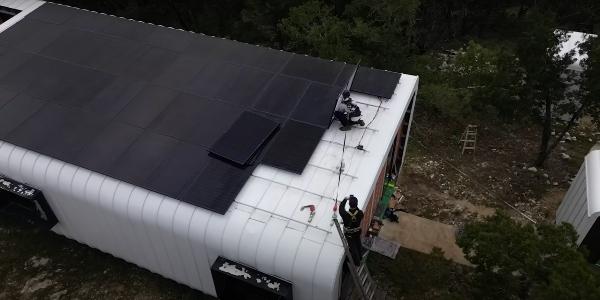UP TO THE MINUTE
Summer of 2024 is the season of solar systems for U.S. and Canadian homeowners

Ready, set, go solar: MRA offers tips to maximize an investment in residential solar systems
Readily available and more affordable than ever, summer of 2024 may go down as the time when residential solar systems make a serious move to mainstream.
The popularity of residential solar systems means more homeowners are re-thinking their relationship with their roofs and how to use all that exterior square footage to do more than just provide shelter over their heads. That includes incorporating residential solar systems to greatly reduce—or even eliminate—their reliance on electric power supplied by their local utility company.
With the longer, sunnier days of summer coinciding with peak re-roofing season, if homeowners are considering the possibility of adding a solar system this year, experts at the Metal Roofing Alliance (MRA) say now is the time to prepare. Re-roofing is the perfect opportunity to incorporate solar, but that means selecting the right material and type of roof that will best support the system for the long term. With that in mind, MRA recently partnered with well-known Austin, Texas builder and social media influencer Matt Risinger of The Build Show to showcase a unique, off-grid residential solar system project in a new video now available at https://www.youtube.com/watch?v=oMV6imtL-Ac
“To keep costs down and protect an investment in solar, it’s important to choose a roof that is strong and durable, as well as allows for uncomplicated installation and long term maintenance,” said Renee Ramey, MRA executive director.
Quality metal roofs last up to 50-plus years, far exceeding the predicted life span not only of typical asphalt roofs but today’s residential solar panels, which are estimated to last roughly 25 – 30 years. That’s critical, because if the roof underneath fails before the panels do, the savings generated by solar can be quickly wiped out. Should a homeowner need to replace a roof before their solar system, they will face not only the cost of repairing or replacing their roof but also the substantial extra labor costs required when removing and reinstalling a solar panel system.
Other important considerations include how the system will attach and be installed on the roof. When installing rooftop solar systems, drilling or penetrating the roofing material or decking should be avoided as much as possible. Rather than screwing or bolting systems into the roof itself, today’s metal roofing systems use specialized clamps and accessories that attach solar systems securely without the need for drills or holes. That keeps the roof weathertight and helps eliminate potential leaks or damage that may ultimately compromise the roof’s integrity.
To stress this point, Risinger highlighted in his latest videos why he considers quality metal roofing and residential solar system installation to be an “unbeatable duo.”
“No rooftop penetrations. That’s got to be the number one reason I like the combination of metal roofing and solar,” said Risinger. “There’s nothing that has to be sealed or weather proofed. We basically leave a weather tight roof in place and simply clamp everything onto it.”
“Compared to a typical asphalt roof, metal is going to go through hail storms and wind storms much better, no problem,” he added.
For homeowners looking to protect their solar system investment, MRA suggests the following:
- Think long term. Metal roofs are the best option for photovoltaic systems, greatly reducing the risk of a roof failing before a solar panel system does. The estimated lifespan of solar panels is typically about 25 to 30 years while metal roofs last for 50-plus years, two or three times the average lifespan of other types of roofing materials. That means the roof will easily outlast the panels.
- Start with a strong base. Metal is exceptionally strong and durable yet lightweight, able to support the weight of heavy solar systems by using a simple attachment and clip solution that does not require drilling holes into the roof or the need for self-ballasted systems, reducing the possibility of roofing failures and potential leaks. Additionally, no structural support is needed to help carry the extra weight of the solar panels.
- Maximize the energy savings. Considered “cool roofs,” metal offers additional energy efficiency benefits, especially combined with solar. Even basic, unpainted metal roofs will reflect more solar radiation than asphalt, which typically absorbs and holds heat. Metal roofs with special coatings deliver high total solar reflectance and high infrared emittance, keeping homes cool and saving energy by re-emitting most of what solar radiation is absorbed.
- Reduce environmental impacts even more. Metal can be 100 percent recycled rather than dumped into a landfill at the end of its long life. It reduces long-term maintenance by naturally resisting moss and fungus, cutting down on the need for strong chemical treatments.
- Consider all-season climate conditions. Even when the sun isn’t shining and solar isn’t top priority, metal stands up better to other climate extremes including hurricane-force winds, severe rain and hailstorms, heavy snowfall and dangers such as wildfires.
- Find a qualified contractor. Some contractors push homeowners towards a certain roofing material, not because it’s the best or most appropriate, but simply because it’s the option the installer is most familiar with. Make sure your installer is properly trained, experienced and skilled in installing metal roofs to accommodate solar panel systems.
For more information or to learn more about today’s quality metal roofs, download a free copy of the MRA’s Metal Roofing Buyer’s Guide at www.metalroofing.com
About Metal Roofing Alliance (MRA)
Representing the residential metal roofing industry in the United States and Canada, the Metal Roofing Alliance (MRA) was formed to help educate consumers about the many benefits of metal roofing. For more information about MRA membership, residential metal roofing resources and tools, visit MRA at www.metalroofing.com.




















Comments
Leave a Reply
Have an account? Login to leave a comment!
Sign In